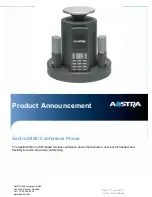
411
Ch
aracter En
try
JUMP
You can move the cursor to the top or end of text.
1
To beginning or To end
≥
When the Character Entry (Edit) display ranges over multiple
pages, the cursor moves to the beginning or end of the page.
Function menu
Operation/Explanation
Information
<Full pitch/Half pitch>
≥
When you switch to half-pitch mode in Kanji/Hiragana input mode of NIKO-touch, the
input mode switches to half-pitch Katakana input mode.
<Pictograph/symbols (Pictograph)>
≥
You might not be able to enter pictographs depending on the Character Entry (Edit)
display.
≥
Once you have entered pictographs, “History” appears first.
≥
Up to 27 records of the pictographs entered in Pictograph 1 and Pictograph 2 and up
to 36 records of Decomail-pictograph are displayed on “History”. However, up to 1
8
records are displayed when the One Seg Viewer display appears below the Message
Composition display.
≥
You can enter up to 20 Decomail-pictographs. When you insert other images,
however, the number of Decomail-pictographs that can be entered is reduced by the
number of inserted images.
<Pictograph/symbols (Symbols)>
≥
You can enter “
+
” by pressing and holding
-
0
for at least one second in Numeral
input mode.
≥
You might not be able to enter some symbols depending on the Character Entry (Edit)
display.
≥
Once you have entered symbols, “History” appears first.
≥
Up to 27 records of the symbols entered in half-pitch and up to 36 records in full-pitch
are displayed on “History”. However, up to 1
8
records are displayed when the One
Seg Viewer display appears below the Message Composition display.
<Phrase/code/quote (Common phrases)>
≥
You might not be able to enter common phrases depending on the Character Entry
(Edit) display.
≥
In Japanese Mode, the called-up contents of common phrases pre-installed in the
FOMA phone differ depending on the input mode.
<Phrase/code/quote (Quote phonebook)>
≥
When you quote a postal address, you cannot quote “
〒
” or “-” of the postal code.
<Phrase/code/quote (Quote own data)>
≥
When you quote a postal address, you cannot quote “
〒
” or “-” of the postal code.
≥
The personal data of Number A is quoted in A Mode of 2in1, the personal data of
Number B is quoted in B Mode, and the personal data of both Number A and Number
B is quoted in Dual Mode.
You can call up and enter, on the Character Entry (Edit) display, the
common phrases pre-installed in the FOMA phone, or your own created
common phrases.
The common phrases are sorted into five folders and each folder
contains 10 of them. You can edit the pre-installed common phrases to
save as your own common phrases.
1
m
1
Stationery
1
Common phrase/dic.
1
Common phrases
1
Select a folder.
2
Select a common
phrase.
<Char. input/dict. (Character set time)>
≥
You might not be able to enter characters as you like depending on this setting and
your speed of operating keys.
+
m
-
3
-
8
<Common Phrases>
Using Common Phrases
Display Common Phrases
Information
Common Phrase
Folder List
Common Phrase List
Common Phrase
display
Information
≥
Do not use half-pitch katakana characters and pictographs for your own common
phrases used for composing mail. They might not be correctly displayed. (Pictographs
can be used between i-mode mail messages.)
≥
In Japanese Mode, the common phrases pre-installed in the “
あいさつ
(Greeting)”
and “
ビジネス
(Business)” folders are called up as kanji/hiragana common phrases in
Kanji/Hiragana input mode and called up as half-pitch katakana common phrases in
other input mode.
Summary of Contents for FOMA P905ITV
Page 50: ...48...
Page 90: ...88...
Page 106: ...104...
Page 128: ...126...
Page 142: ...140...
Page 190: ...188...
Page 300: ...298...
Page 436: ...434...
Page 511: ...509 Index Quick Manual Index 510 Quick Manual 518...
Page 592: ...Kuten Code List...
















































